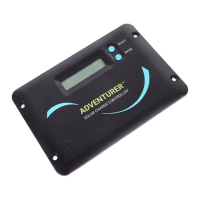15
Float Charge: After Boost Charge, the controller will reduce the battery voltage to a float
voltage set point. Once the battery is fully charged, there will be no more chemical
reactions and all the charge current would turn into heat or gas. Because of this, the charge
controller will reduce the voltage charge to smaller quantity, while lightly charging the
battery. The purpose for this is to offset the power consumption while maintaining a full
battery storage capacity. In the event that a load drawn from the battery exceeds the
charge current, the controller will no longer be able to maintain the battery to a Float set
point and the controller will end the float charge stage and refer back to bulk charging.
Boost Charge:
Bulk Charge: This algorithm is used for day to day charging. It uses 100% of available
solar power to recharge the battery and is equivalent to constant current.
When the battery has charged to the Boost voltage set-point, it undergoes
an absorption stage which is equivalent to constant voltage regulation to prevent heating
and excessive gassing in the battery. The Boost time is 120 minutes.
The Adventurerhas a 4-stage battery charging algorithm for a rapid, efficient, and safe
battery charging. They include: Bulk Charge, Boost Charge, Float Charge, and Equalization.
TIME
NIGHT
BOOST
EQUALIZE
FLOAT
NIGHT
BULK
CHARGE
VOLTAGE
The Adventurer utilizes Pulse Width Modulation (PWM) technology for battery charging.
Battery charging is a current based process so controlling the current will control the
battery voltage. For the most accurate return of capacity, and for the prevention of
excessive gassing pressure, the battery is required to be controlled by specified voltage
regulation set points for Absorption, Float, and Equalization charging stages. The charge
controller uses automatic duty cycle conversion, creating pulses of current to charge the
battery. The duty cycle is proportional to the difference between the sensed battery
voltage and the specified voltage regulation set point. Once the battery reached the
specified voltage range, pulse current charging mode allows the battery to react and
allows for an acceptable rate of charge for the battery level.
PWM Technology
Four Charging Stages
EN

